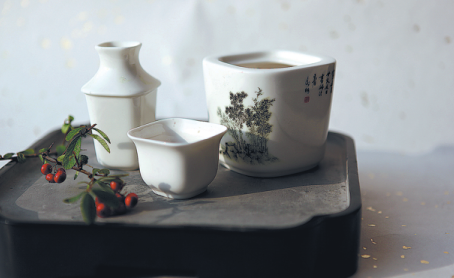
 Suzhou Museum's drinking set designed to warm wine, printed with part of a painting by Wen Zhengming, a scholar-artist from the Ming Dynasty (1368-1644). CHINA DAILY
Suzhou Museum's drinking set designed to warm wine, printed with part of a painting by Wen Zhengming, a scholar-artist from the Ming Dynasty (1368-1644). CHINA DAILY
Museums have a focus on the past. It's the main part of their raison d'etre. But that does not exclude acknowledging that they have a role to play in today's society.
Chen Xiao bought a canvas bag online from the National Museum of China in Beijing, printed with three characters from an ancient painting at the museum. The way they are displayed on the bag, with its colorful straps integrated into the graphic design, the three figures appear as if they are playing with a skipping rope. It's one of the museum's popular creative cultural products.
More people, like Chen, are buying such products, either for daily use or as tourism souvenirs.
"Traditional culture contains many beautiful elements that seem far-removed from our life, but such products connect our complex desire and need to connect with the past. It's just like a bridge," says Chen, an office worker from Beijing.
In August 2019, Tsinghua University and business-to-customer platform Tmall co-released a report about the consumption of creative cultural products. The report said in the previous year, until June 2019, for the first time, the number of those who visited museums online surpassed that of the number who visited real museums, and that the amount of online visits to museums was 1.5 times of those who visited museums physically.
The report notes that the data for the 12 months prior to publishing showed that, of those who bought museum products at least three times in that period, over half were born in the 1990s and 2000s. It added that 80 percent were female, and 74 percent lived in first-and second-tier cities.
From July 2018 to June 2019, sales of such museum products on Alibaba platforms increased by three times, compared with sales from July 2016 to June 2017. Most were daily-use items, necessities, cosmetics and snacks.